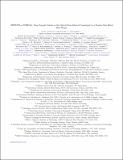Por favor, use este identificador para citar o enlazar a este item:
http://hdl.handle.net/10261/218992COMPARTIR / EXPORTAR:
 SHARE SHARE
 CORE
BASE CORE
BASE
|
|
| Visualizar otros formatos: MARC | Dublin Core | RDF | ORE | MODS | METS | DIDL | DATACITE | |

| Título: | GROWTH on S190814bv: Deep Synoptic Limits on the Optical/Near-infrared Counterpart to a Neutron Star-Black Hole Merger |
Autor: | Andreoni, Igor; Goldstein, Daniel A.; Kasliwal, Mansi M.; Nugent, Peter E.; Zhou, Rongpu; Newman, Jeffrey A.; Bulla, Mattia; Foucart, Francois; Hotokezaka, Kenta; Nakar, Ehud; Nissanke, Samaya; Raaijmakers, Geert; Bloom, Joshua S.; De, Kishalay; Jencson, Jacob E.; Ward, Charlotte; Ahumada, Tomás; Anand, Shreya; Buckley, David A. H.; Caballero-García, María Dolores; Castro-Tirado, Alberto J. CSIC ORCID ; Copperwheat, Christopher M.; Coughlin, Michael W.; Cenko, S. Bradley; Gromadzki, Mariusz; Hu, Youdong; Karambelkar, Viraj R.; Perley, Daniel A.; Sharma, Yashvi; Valeev, Azamat F.; Cook, David O.; Fremling, U. Christoffer; Kumar, Harsh; Taggart, Kirsty; Bagdasaryan, Ashot; Cooke, Jeff; Dahiwale, Aishwarya; Dhawan, Suhail; Dobie, Dougal; Gatkine, Pradip; Golkhou, V. Zach; Goobar, Ariel; Chaves, Andreas Guerra; Hankins, Matthew; Kaplan, David L.; Kong, Albert K. H.; Kool, Erik C.; Mohite, Siddharth; Sollerman, Jesper; Tzanidakis, Anastasios; Webb, Sara; Zhang, Keming | Palabras clave: | On 2019 August 14, the Advanced LIGO and Virgo interferometers detected the high-significance gravitational wave (GW) signal S190814bv. The GW data indicated that the event resulted from a neutron star-black hole (NSBH) merger, or potentially a low-mass binary BH merger. Due to the low false-alarm rate and the precise localization (23 deg2 at 90%), S190814bv presented the community with the best opportunity yet to directly observe an optical/near-infrared counterpart to an NSBH merger. To search for potential counterparts, the GROWTH Collaboration performed real-time image subtraction on six nights of public Dark Energy Camera images acquired in the 3 weeks following the merger, covering >98% of the localization probability. Using a worldwide network of follow-up facilities, we systematically undertook spectroscopy and imaging of optical counterpart candidates. Combining these data with a photometric redshift catalog, we ruled out each candidate as the counterpart to S190814bv and placed deep, uniform limits on the optical emission associated with S190814bv. For the nearest consistent GW distance, radiative transfer simulations of NSBH mergers constrain the ejecta mass of S190814bv to be M ej < 0.04 M o&dot at polar viewing angles, or M ej < 0.03 M o&dot if the opacity is κ < 2 cm2g-1. Assuming a tidal deformability for the NS at the high end of the range compatible with GW170817 results, our limits would constrain the BH spin component aligned with the orbital momentum to be χ < 0.7 for mass ratios Q < 6, with weaker constraints for more compact NSs. © 2020. The American Astronomical Society. All rights reserved. |
Fecha de publicación: | 2020 | Editor: | IOP Publishing | Citación: | Astrophysical Journal 890(2): 131 (2020) | Resumen: | On 2019 August 14, the Advanced LIGO and Virgo interferometers detected the high-significance gravitational wave (GW) signal S190814bv. The GW data indicated that the event resulted from a neutron star-black hole (NSBH) merger, or potentially a low-mass binary BH merger. Due to the low false-alarm rate and the precise localization (23 deg at 90%), S190814bv presented the community with the best opportunity yet to directly observe an optical/near-infrared counterpart to an NSBH merger. To search for potential counterparts, the GROWTH Collaboration performed real-time image subtraction on six nights of public Dark Energy Camera images acquired in the 3 weeks following the merger, covering >98% of the localization probability. Using a worldwide network of follow-up facilities, we systematically undertook spectroscopy and imaging of optical counterpart candidates. Combining these data with a photometric redshift catalog, we ruled out each candidate as the counterpart to S190814bv and placed deep, uniform limits on the optical emission associated with S190814bv. For the nearest consistent GW distance, radiative transfer simulations of NSBH mergers constrain the ejecta mass of S190814bv to be M < 0.04 M at polar viewing angles, or M < 0.03 M if the opacity is κ < 2 cmg. Assuming a tidal deformability for the NS at the high end of the range compatible with GW170817 results, our limits would constrain the BH spin component aligned with the orbital momentum to be χ < 0.7 for mass ratios Q < 6, with weaker constraints for more compact NSs. | Versión del editor: | http://dx.doi.org/10.3847/1538-4357/ab6a1b | URI: | http://hdl.handle.net/10261/218992 | DOI: | 10.3847/1538-4357/ab6a1b | Identificadores: | doi: 10.3847/1538-4357/ab6a1b e-issn: 1538-4357 issn: 0004-637X |
| Aparece en las colecciones: | (IAA) Artículos |
Ficheros en este ítem:
| Fichero | Descripción | Tamaño | Formato | |
|---|---|---|---|---|
| IAA_2020ApJ...890..131A.pdf | 1,39 MB | Adobe PDF |  Visualizar/Abrir |
CORE Recommender
SCOPUSTM
Citations
76
checked on 21-abr-2024
WEB OF SCIENCETM
Citations
60
checked on 26-feb-2024
Page view(s)
192
checked on 30-abr-2024
Download(s)
80
checked on 30-abr-2024
Google ScholarTM
Check
Altmetric
Altmetric
NOTA: Los ítems de Digital.CSIC están protegidos por copyright, con todos los derechos reservados, a menos que se indique lo contrario.
